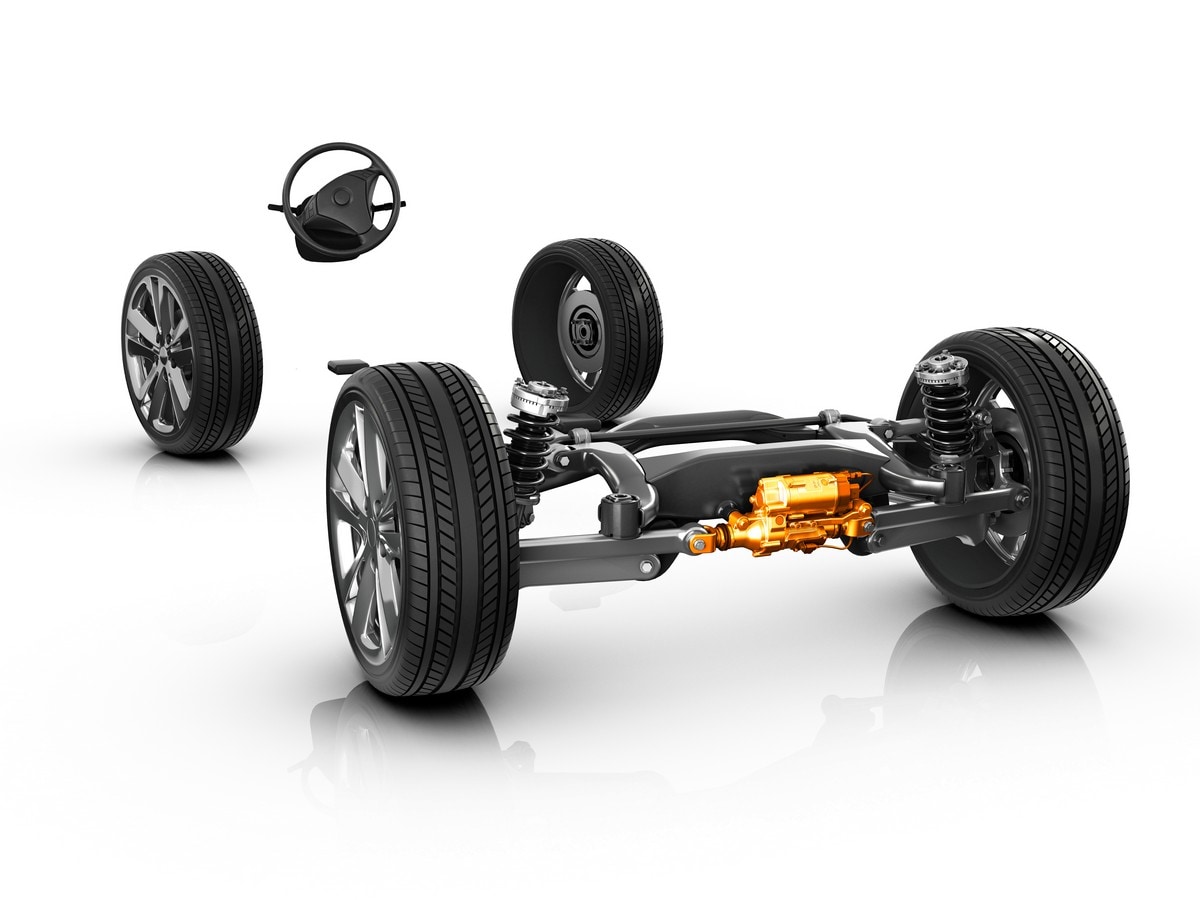- Rear-wheel steering helps prevent and/or control trailer sway
- Aids trailer backing and braking on slippery surfaces
- Provides stability in abrupt maneuvers
- Help in tightening turning circles
- Likely to be a $1,500-$2,000 option
Anyone who has towed a trailer, large or small, has probably experienced the cringe-inducing onset of trailer sway. You feel it pulling the back of your tow vehicle one way, then the other while watching it swinging side-to-side-to-side in your mirrors. Lifting off the gas or braking can make it worse, while (counter-intuitively) gently accelerating can help to stabilize it. But if it continues and builds to extremes, it can damage or shed whatever is in or on your trailer and can cause a loss of control with serious consequences. And even when you correctly steer to counter it, a swaying trailer is always annoying and sometimes scary.
Most modern trucks and truck-based SUVs equipped for towing have a standard or available trailer sway control feature (via automatic selective rear-wheel braking and/or interaction through the hitch). Some premium hitches claim to prevent sway, and modern, high-quality trailers are less susceptible to it. But what if your tow vehicle could sense sway as it starts to happen and almost imperceptibly countersteer its back wheels to control it?
All-wheel steering to the rescue
That is one important advantage of German supplier ZF’s Active Kinematics Control (AKC), which slightly steers a vehicle’s rear wheels in the same direction as its fronts to keep it tracking straight and true (with or without a trailer) at highway speeds, stabilize it during lane changes and reduce the need for driver corrections during trailering. It also aids braking, eases backing a trailer (and keeping it from jack-knifing) and — by turning the rear wheels opposite to the fronts — reduces a vehicle’s turning circle for better maneuvering in tight spaces.
Think about it. Any time you dodge a pothole or make a quick lane change, the back of your vehicle follows the front, but with a slight delay, which can cause an unbalance, a minor fishtail or — especially on slick surfaces — a rear-wheel skid. But if your rear wheels turn the same direction as the fronts at the same time, the vehicle can scoot one way or the other with much more stability. And at low (parking) speeds, if the rears turn the opposite direction as the fronts, it can turn more sharply for U-turns and tight-space maneuvering.
History of rear-wheel steering
Rear-wheel (aka four-wheel) steer has been around for years and is fairly common on farm and construction equipment, “monster” trucks and some large European buses. Honda offered it as an option on its 1987 Prelude, Mazda tried it on 1988 626 sedans, and General Motors offered “Quadrasteer” on 2002 to 2005 Chevrolet and GMC pickups and SUVs. But all of those options were discontinued for lack of customer interest, primarily because their prices far outweighed their perceived benefits.
In recent years, however, newer generations of 4-wheel steering have become available, either in packages or as stand-alone options, on a growing number of (mostly luxury) cars, CUVs and SUVs. And the majority are ZF AKC systems, which are now offered on European and some U.S.-market Audi A6, A7, A8 and Q7, BMW 5, 6, 7, X5, X6 and X7, Porsche 911 and Panamera. The supplier reports that it has built a half-million AKC systems in less than six years since their production began. And ZF is now targeting U.S. pickups and SUVs, where they make a lot of sense for a lot of reasons, including highway stability, braking, towing and low-speed maneuverability.
How it works
ZF supplies two variants of AKC. A central-actuator version is ideal for front-drive vehicles and larger pick-ups and SUVs, while a dual-actuator system uses one on each rear wheel to save space for a fuel tank, the driveshaft and rear axle of a rear-drive car, even the engine and transaxle of a rear-engine Porsche.
To test AKC, we tried a series of maneuvers in a full-size light-duty pickup fitted with the central-actuator version, both with and without a 7,000-lb. trailer, at ZF’s Michigan test facility, and its benefits became quickly obvious. With the system switched off, the trailer swayed noticeably in lane-change tests…but not with it switched on. It also improved stability without the trailer and helped stabilize hard braking with one side of the truck on a wetted-down slick surface. At low speeds, it made negotiating a tight, cone-lined slalom much easier and enabled a (19-percent) tighter turning circle than the truck could manage with the system turned off.
How much does 4-wheel steering cost?
So, we’re convinced that AKC would be a worthy driver assist and safety enhancer on most any truck or SUV, whether or not it’s used for trailering. No U.S. truck-maker yet offers such a system, but we can speculate that its retail price would be in the $1,500-$2,000 range. For example, Audi offers “Dynamic All-Wheel Steering” for $1,950 as a stand-alone option on the U.S. A8, BMW offers “Integral Active Steering” for $1,150 on a variety of models, and Porsche charges $1,620 for “Rear-Axle Steering” on the Cayenne SUV and Panamera sedan and $2,090 on some 911 sports cars.
It probably won’t be long before we’ll see it becoming available on an increasing number of U.S. truck and SUV option lists as well as other vehicles especially since it supports automated driving. It has the potential to partially steer a vehicle — to keep it lane-centered, for example — without turning the front wheels. And it’s suitable for hybrids and pure electrics as well as conventional combustion-engine vehicles.









